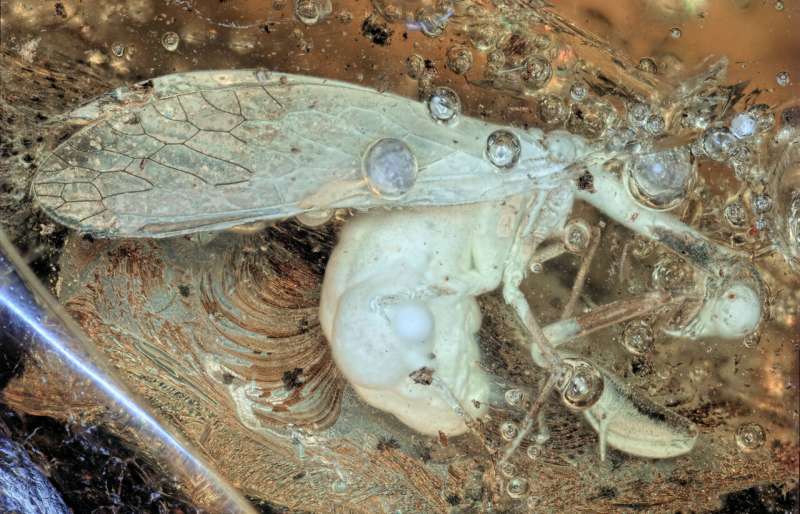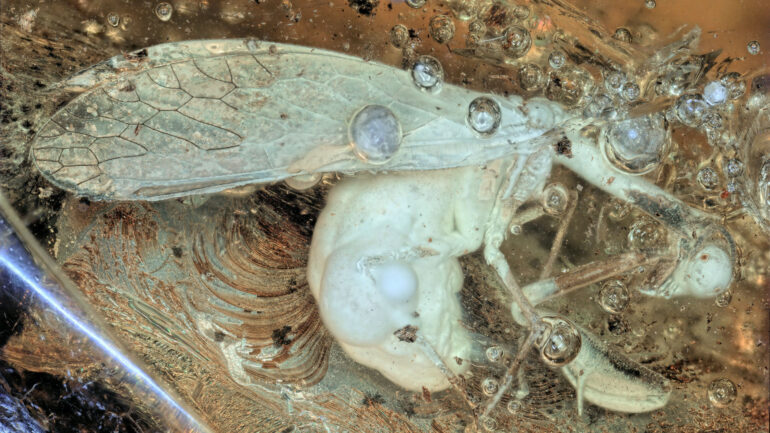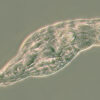Lacewings (Neuroptera) are small predatory insects, whose larvae are sometimes used as pest control agents in agriculture. Few non-specialists, however, know that some lacewings can look a lot like praying mantises.
Mantis lacewings (Mantispida) are among the most charismatic true lacewings. They are 5–47 mm long and have prominent grasping legs that act as snap traps for unsuspecting prey. These legs, also called raptorial, give them the mantis-like look. The resemblance is due to convergent evolution—a process where different organisms acquire similar traits as they adapt to similar conditions.
Even though these insects have a long geological record, dating back all the way to the Cretaceous, no adult individuals have been recorded from Baltic amber. This is surprising, given that the fossil deposit is the largest and one of the best-studied in the world.
This changed last year, when a research team led by Viktor Baranov of Ludwig-Maximilians-Universität München came across a beautiful specimen from the Yantarny mine in Kaliningrad oblast, Russia. Jonas Damzen, a private amber collector and supporter of palaeoentomology research, brought the specimen to the researchers’ attention.
After analyzing its morphology, the paleontologists found out that it was closely related to the extant lacewing genus Mantispa. Important characters, however, such as rear wing venation and genitalia were obscured by so called “verlummung”—a white film which covers many of the fossils in Baltic amber. That made it impossible to conclusively confirm the insect’s identity.

© V. Baranov
“So, to deal with this uncertainty, we designated this specimen as ‘probable Mantispa’ (Mantispa?),” Baranov explains. In the team’s research article published in the journal Fossil Record, they present it as Mantispa? damzenogedanica. The name is a combination of “Damzen,” honoring Jonas Damzen, who found it, and “gedanicum,” referring to a Latin name for Gdańsk, Poland, where the local museum keeps the specimen.
The researchers were still baffled as to why more individuals of mantis lacewings haven’t been found from Baltic amber.
Baltic amber deposits formed in the mid-to-late Eocene epoch (38–33.9 MYA) in Northern Europe. Current consensus on the climate of the area at the time stands that it was warm-temperate. “Such climate is in fact perfect for extant mantis lacewings,” Baranov comments. “So it is logical to suggest that unsuitable climate was not the main reason for the rarity of these animals in Baltic amber.”
Analyzing how the shape of mantis lacewings changed over time, the team found a surprising trend—since the Cretaceous, the diversity in the shape of their legs has decreased. “While the shape of the raptorial legs in the Cretaceous was characterized by eclectic, amazing diversity, later mantis lacewings have a rather uniform shape of raptorial legs,” Baranov explains.
The team is not exactly sure what caused the decline, but they have a theory. “We think that drastic biotic changes after the Cretaceous-Paleogene extinction event (the mass extinction that killed the dinosaurs) may have led to the environment becoming less conductive to mantis lacewings, which in turn decreased their diversity.”
Baranov is excited to share the discovery of the first mantis lacewing from Baltic amber, as it offers “a rare glimpse into a time when, in the world after dinosaurs, lacewings got a little less diverse and charismatic.”
More information:
Viktor Baranov et al, The first adult mantis lacewing from Baltic amber, with an evaluation of the post-Cretaceous loss of morphological diversity of raptorial appendages in Mantispidae, Fossil Record (2022). DOI: 10.3897/fr.25.80134
Provided by
Pensoft Publishers
Citation:
30-million-year-old Baltic amber reveals a lacewing that looks like a mantis (2022, March 22)



